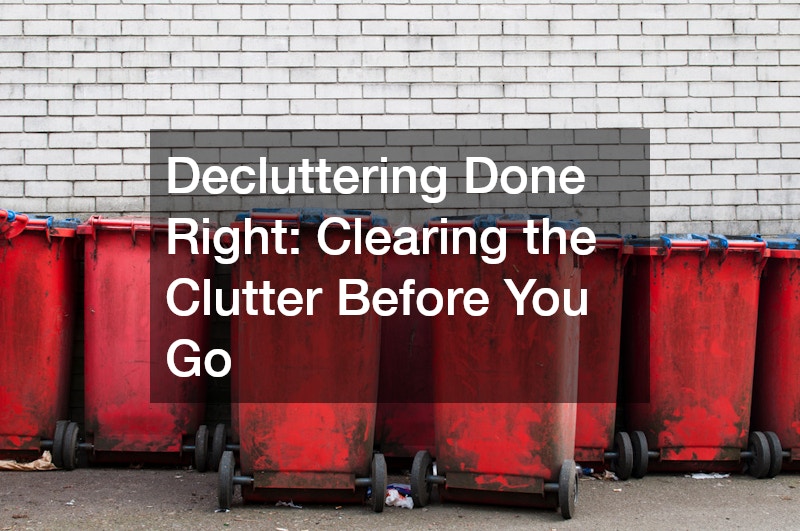When most people prepare to move, they think about boxes, packing tape, and trucks—but those are just the basics. The real art of a stress-free move comes from understanding how to simplify each step before, during, and after the big day. Moving simplified isn’t just a phrase—it’s a mindset that blends preparation, resourcefulness, and smart planning. Beyond packing, it’s about managing time, cutting clutter, and easing transitions in ways that most homeowners overlook.
Whether you’re relocating across town or across state lines, every move brings its own set of challenges. You might be coordinating multiple schedules, balancing work commitments, and trying to keep your home functional while packing up your life. Simplifying this process requires a strategy that’s equal parts organization and creativity. From professional partnerships and storage solutions to selling unwanted items and preparing both your old and new homes, there are dozens of details that often go unnoticed—but make all the difference when handled correctly.
This guide explores what moving simplified truly looks like beyond the obvious. It covers unique tools, services, and systems you may not have thought to use—but that can drastically reduce stress, save time, and help you start your next chapter with clarity and control.
Planning with Purpose: The Foundation of a Smooth Move
Planning is where moving simplified begins. A move is never just about boxes—it’s a large-scale project that demands foresight. Establishing a well-structured plan prevents the last-minute scrambling that so many movers experience. Start by mapping your timeline: when to notify utility providers, when to schedule professional help, and when to begin packing non-essentials. By spacing out tasks, you eliminate the panic that comes from trying to do everything at once.
Create a checklist that includes both logistical and emotional tasks. For example, take photos of your old rooms for reference before unpacking, label each box by room and priority, and note important account updates—such as mailing addresses, voter registration, and subscriptions. Treat the move as a project with milestones, not a single event.
The biggest planning mistake people make is underestimating how long preparation takes. Give yourself double the time you think you need for packing, cleaning, and decision-making. It’s also helpful to use a shared digital planner or calendar if more than one person is involved. This centralizes tasks and keeps everyone on track. Don’t forget to budget both time and money. Many unexpected costs—like packing materials, transportation fees, or last-minute cleaning supplies—can add up fast. A realistic budget will reduce surprises and help you stay calm.
Ultimately, moving simplified is about staying proactive rather than reactive. The more effort you put into planning early, the less you’ll have to problem-solve later. When your calendar, to-do lists, and expectations are in sync, you’re free to focus on what matters most—settling into your new space with peace of mind.
Partnering with Professionals Who Make a Difference
Choosing the right help transforms a chaotic move into an efficient one. Partnering with a reputable moving service ensures that your possessions are handled with care and delivered safely. Instead of trying to manage everything yourself, professionals bring the experience and equipment necessary to handle bulky furniture, fragile items, and heavy loads efficiently.
If you’re relocating within your area, hiring local movers has distinct advantages. They’re familiar with the region, understand local traffic patterns, and often offer flexible scheduling. However, if your new destination is several states away, working with a trusted interstate moving company becomes essential. These companies specialize in long-distance logistics, coordinating transport routes, timing, and regulations across state lines to ensure a seamless transition.
The right moving professionals do more than transport boxes—they can assist with packing, provide insurance coverage, and even help set up large items upon arrival. Look for companies that perform in-person or virtual estimates to give accurate pricing. Reading customer reviews and verifying licenses can prevent unpleasant surprises and ensure that your belongings are in capable hands.
Communication is key. Provide movers with details about access points, staircases, elevators, and any potential parking limitations. The more information they have, the smoother the day will go. Clear labeling of boxes also helps professionals place everything in the right rooms, saving you hours of rearranging later.
A professional team can turn moving from an idea into a reality. Instead of juggling a dozen tasks, you can focus on transitioning emotionally and logistically, knowing that experts are handling the heavy lifting—literally and figuratively.
Streamlining with Smart Storage Solutions
Not everything needs to move at once. One of the most overlooked yet effective ways to simplify moving is by incorporating smart storage into your strategy. Temporary storage options, such as moving and storage facilities, allow you to declutter before packing, giving you space to sort, donate, or sell items without feeling rushed.
Using roll off containers can be another efficient way to stay organized. These large, portable containers can be delivered to your driveway and filled at your own pace. Once packed, they can be transported directly to your new location or kept in a secure storage facility until you’re ready for them. This approach eliminates the stress of coordinating multiple trips and reduces clutter in your living space as you prepare to move.
Storage solutions also help bridge gaps between move-out and move-in dates. For instance, if your new home isn’t ready yet, storing non-essential belongings can prevent unnecessary chaos. Label containers carefully and group items by purpose—such as seasonal décor, tools, or archived documents—so you can retrieve them easily when needed. By investing in flexible storage, you’re not just renting space; you’re buying time and clarity. With moving simplified as your guiding principle, storage becomes an asset that keeps your move efficient, your home less cluttered, and your stress levels low.

Decluttering Done Right: Clearing the Clutter Before You Go
Before you pack, take time to declutter. Nothing complicates a move faster than hauling things you no longer use. Thoughtful downsizing is essential to keeping moving simplified from becoming overwhelming. Start by tackling one room at a time and creating four piles: keep, donate, sell, and discard. To manage the discard pile efficiently, a dumpster rental can be a game-changer. It allows you to dispose of unwanted materials—like old furniture, broken appliances, or years of accumulated clutter—without multiple trips to the landfill.
For items that can be recycled or reused, a local scrap yard is worth considering. Many accept old metal furniture, appliances, or even car parts that might otherwise end up in a dumpster. You may even earn a small amount of money in return, which can offset moving costs. Decluttering ahead of time also gives you a sense of control. It’s emotionally freeing to let go of things that no longer serve you, especially before entering a new space. The more you eliminate now, the less you’ll have to unpack later.
In the spirit of moving simplified, decluttering isn’t about getting rid of everything—it’s about intentional living. Keep what adds value or meaning, and part with what doesn’t. The result is a lighter move, a clearer mind, and a home that truly reflects your priorities.
Comfort in Transition: Preparing Your Old and New Spaces
While packing and transport are the focus for most people, maintaining livable conditions in both your old and new spaces is equally important. Preparation is what turns moving simplified into a practical lifestyle.
One small but surprisingly helpful service is porta potty rental. If your bathrooms are being cleaned, remodeled, or packed with supplies, a temporary restroom can keep things hygienic and convenient during move-out days. It’s also an excellent solution when hosting movers, cleaners, or contractors—especially if water or plumbing has been turned off early. Keeping your old home clean until the final walkthrough is essential. A spotless space not only respects the next occupants but also increases the likelihood of getting your security deposit back if you’re renting. Plan a final cleaning day after the movers leave, using basic tools like vacuums, mops, and all-purpose cleaners.
For your new space, consider setting up a “first-night kit.” This should include bedding, toiletries, snacks, and any essentials like phone chargers or medications. That way, you can settle in comfortably without digging through boxes. Remember that moving simplified isn’t just about logistics—it’s also about well-being. By keeping your environment functional and clean during transition, you set the stage for a smooth start in your next home.
Selling What You Don’t Need: Turning Extras into Earnings
Instead of packing up every item, think of your move as an opportunity to refresh your lifestyle. Selling unused or unwanted belongings can lighten your load while generating extra funds. Using an online auction platform is one of the most convenient ways to do this.
These platforms connect sellers with buyers across the country, offering a quick and efficient way to sell collectibles, furniture, electronics, and even vehicles. High-quality photos and honest descriptions increase your chances of getting a good price. Online selling also helps reduce waste by giving items a second life instead of sending them to the landfill.
To make this step part of moving simplified, start the process early. The more time you have to list and sell, the more selective you can be about pricing and buyers. Some services even offer shipping assistance or local pickup options.
Not only does selling reduce moving volume, but it also creates a sense of renewal. Letting go of the old and earning something from it can feel empowering. Every box you don’t move is one less to pack, transport, and unpack—saving you time, effort, and space in your new home. By incorporating selling into your strategy, you’re not just clearing clutter—you’re turning change into opportunity. That’s what moving simplified is truly about: efficiency with purpose.
Overlooked Essentials: The Role of the Right Supplies
Every move is only as organized as the tools you use. Having the right moving supplies may sound simple, but many people underestimate their importance. Boxes, packing tape, labels, bubble wrap, and furniture blankets are the unsung heroes of an efficient relocation.
Start by taking inventory of what you’ll need and ordering extra supplies in advance. Running out of boxes mid-move can cause frustration and delays. Opt for sturdy materials—thin or reused boxes may collapse under heavy loads. Label each box with its destination room and contents for easy unpacking. Color-coding can also make a huge difference. Assign colors to rooms or categories, such as red for kitchen items or blue for bedroom essentials. This system speeds up unloading and reduces confusion.
Another overlooked tip for moving simplified is keeping a “last packed, first opened” box. Include essentials such as scissors, tools, cleaning wipes, light bulbs, and extension cords. Having these items readily accessible can save hours once you arrive.
Protect furniture with plastic wrap or padded covers, and disassemble larger items in advance. Keep screws and hardware in labeled bags taped directly to their corresponding furniture pieces. By investing in proper supplies and staying organized, you create an environment where each stage of the move runs smoothly, minimizing damage and maximizing efficiency.

Settling In Smoothly: Making Your New Place Feel Like Home
The move doesn’t end once the boxes are delivered. The final phase of moving simplified is about transforming your new space into a functional, comfortable home. Unpacking can be overwhelming, but approaching it strategically makes the process manageable. Begin with essentials: kitchen items, bedding, and bathroom supplies. Once those areas are set up, your new home will feel immediately livable. Prioritize rooms you’ll use daily, and resist the urge to unpack everything at once. Pace yourself—your goal is organization, not speed.
As you unpack, take the opportunity to refine your layout. Maybe your furniture fits differently in this new space, or you finally have the chance to design rooms around your current lifestyle. Take photos as you go—it can help you visualize improvements and track progress. Meet your neighbors early on. Community connections are a huge part of settling in, whether it’s borrowing tools, getting local recommendations, or simply having someone nearby who can lend a hand.
Finally, treat yourself to a “welcome home” moment. Light a candle, cook a meal, or play your favorite music. These small rituals make your new environment feel personal and grounded. Moving simplified ends not with unpacking, but with feeling truly at home.


